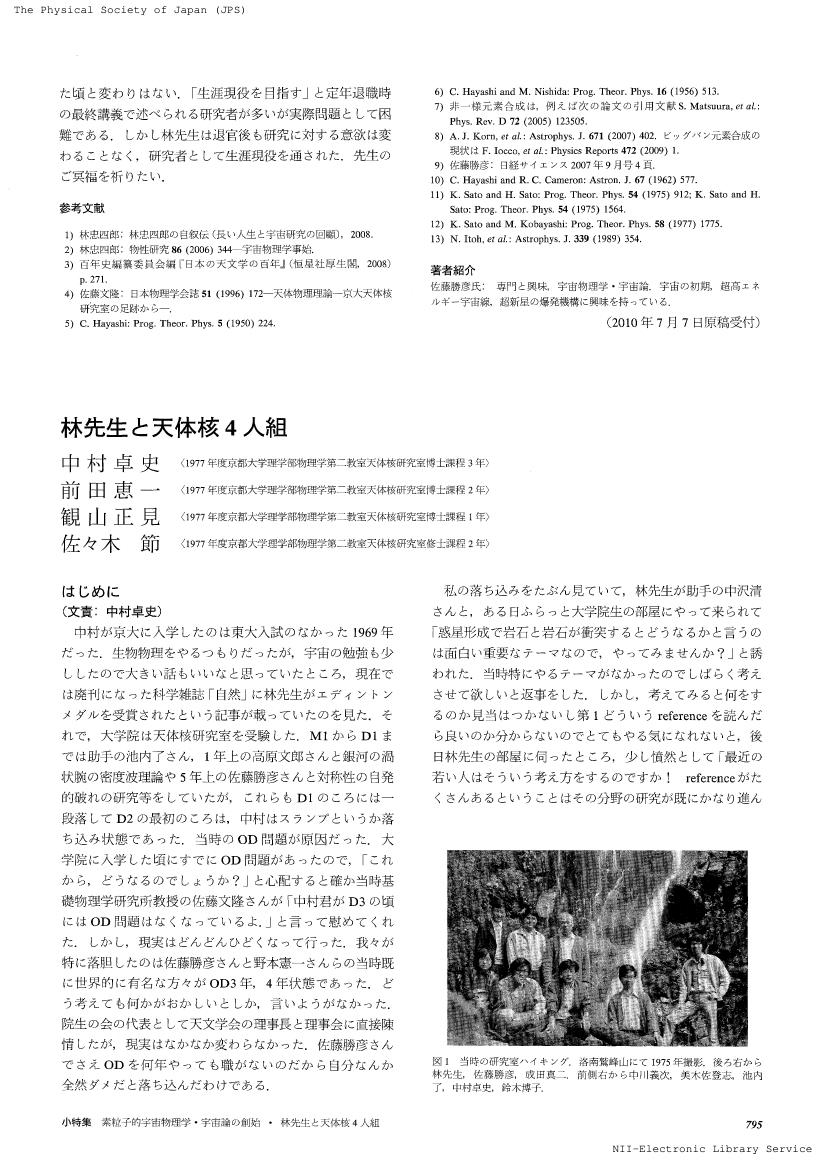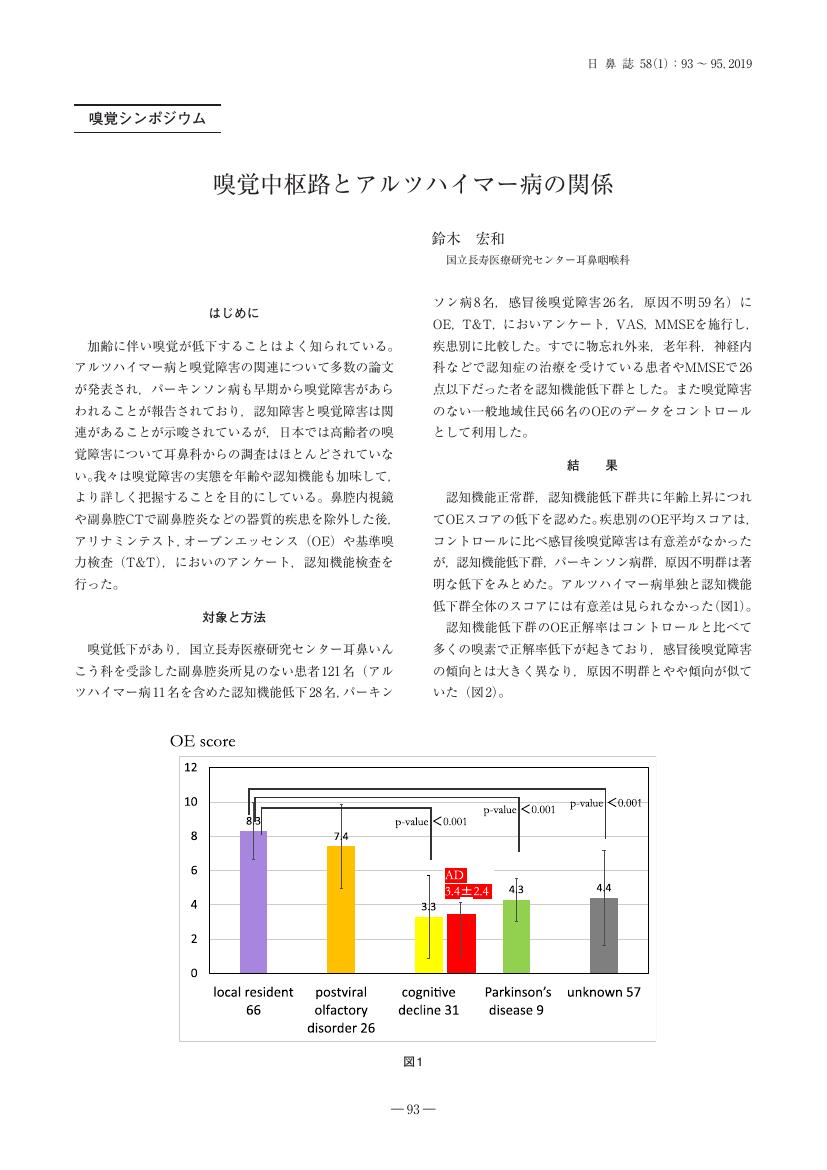14 0 0 0 精神障害のカテゴリカル診断を超えた心理学的アプローチの可能性
- 著者
- .企画代表者(Representative Organizer)岡 大樹 .話題提供者(Speaker)岡 大樹 .松本 昇 .平井 啓 .遠山 朝子 .指定討論者(Discussant)国里 愛彦 .司会者(Chair)岡 大樹
- 雑誌
- 日本心理学会第87回大会
- 巻号頁・発行日
- 2023-08-03
- 著者
- Koji Ito Kenji Miyata Masahiro Mohri Hideki Origuchi Hideo Yamamoto
- 出版者
- 一般社団法人 日本内科学会
- 雑誌
- Internal Medicine (ISSN:09182918)
- 巻号頁・発行日
- vol.56, no.1, pp.23-29, 2017-01-01 (Released:2017-01-01)
- 参考文献数
- 15
- 被引用文献数
- 16
Objective It is recommended that middle-aged and elderly individuals reduce their salt intake because of the high prevalence of hypertension. The consumption of miso soup is associated with salt intake, and the reduced consumption of miso soup has been recommended. Recent studies have demonstrated that the consumption of miso soup can attenuate an autonomic imbalance in animal models. However, it is unclear whether these results are applicable to humans. This study examined the cross-sectional association between the frequency of miso soup consumption and the blood pressure and heart rate of human subjects. Methods A total of 527 subjects of 50 to 81 years of age who participated in our hospital health examination were enrolled in the present study and divided into four groups based on the frequency of their miso soup consumption ([bowl(s) of miso soup/week] Group 1, <1; Group2, <4; Group3, <7; Group4, ≥7). The blood pressure levels and heart rates of the subjects in each group were compared. Furthermore, a multivariable analysis was performed to determine whether miso soup consumption was an independent factor affecting the incidence of hypertension or the heart rate. Results The frequency of miso soup consumption was not associated with blood pressure. The heart rate was, however, lower in the participants who reported a high frequency of miso soup consumption. A multivariable analysis revealed that the participants who reported a high frequency of miso soup consumption were more likely to have a lower heart rate, but that the consumption of miso soup was not associated with the incidence of hypertension. Conclusion These results indicate that miso soup consumption might decrease the heart rate, but not have a significant effect on the blood pressure of in middle-aged and elderly Japanese individuals.
14 0 0 0 OA 発達障害とトラウマ
- 著者
- 杉山 登志郎
- 出版者
- 一般社団法人 日本児童青年精神医学会
- 雑誌
- 児童青年精神医学とその近接領域 (ISSN:02890968)
- 巻号頁・発行日
- vol.58, no.4, pp.544-549, 2017-08-01 (Released:2019-08-21)
- 参考文献数
- 16
14 0 0 0 OA ナウマンゾウの「ナウマン」は-日本で最初の地質学教授のこと
- 著者
- 矢島 道子
- 出版者
- 公益財団法人 日本学術協力財団
- 雑誌
- 学術の動向 (ISSN:13423363)
- 巻号頁・発行日
- vol.13, no.8, pp.93-97, 2008-08-01 (Released:2012-10-30)
- 参考文献数
- 7
14 0 0 0 OA スポーツにおけるルールの根拠に関する一考察 ―ルールの妥当性の根拠を導く解釈的アプローチ―
- 著者
- 松宮 智生
- 出版者
- 日本体育・スポーツ哲学会
- 雑誌
- 体育・スポーツ哲学研究 (ISSN:09155104)
- 巻号頁・発行日
- vol.34, no.1, pp.37-51, 2012 (Released:2012-12-17)
- 参考文献数
- 48
The purpose of this paper is to clarify the basis of the validity of rules of game.The traditional framework of the discussion (formalism vs. ethos theory, internalism vs. externalism, etc.) cannot answer the issue mentioned above.The author seeks to verify whether the basis of the effectiveness of rules (the basis for rules to function as rules) is the basis of validity of the rules (the basis for the appropriateness of the content of the rules).The author then presents a framework for discussion of positivism vs. interpretivism. This structure of discussion corresponds to the legal positivism vs. Dworkin dispute in the philosophy of law.Positivism emphasizes norms based on facts such as written rules and customs and is effective for discussing the rationale for the effectiveness of rules.Interpretivism, in contrast, focuses on the interpretation of rules supporting integration of the rule system and is useful for discussing the rationale for the validity of rules. An interpretive approach seeking to find the ethos (or principles) of games may identify the basis of the validity of rules.Even if a player engages in conduct conforming to the rule of games, i.e., rational behavior to win without violating the rules, his/her actions may be criticized by those who watch. If so, the validity of the rules that are the basis for rational behavior may be questioned. The problem is the relationship between the ethos (or principles) of games and the rules.
14 0 0 0 OA 自閉スペクトラムの認知特性と視覚芸術
- 著者
- 華園 力
- 出版者
- 日本視覚学会
- 雑誌
- VISION (ISSN:09171142)
- 巻号頁・発行日
- vol.30, no.4, pp.171-178, 2018 (Released:2018-10-25)
- 参考文献数
- 36
14 0 0 0 OA 一九〇五年「第二次日韓協約」
- 著者
- 海野 福寿
- 出版者
- 明治大学史学地理学会
- 雑誌
- 駿台史學 (ISSN:05625955)
- 巻号頁・発行日
- vol.91, pp.1-34, 1994-03-30
14 0 0 0 OA 林先生と天体核4人組(<小特集>林忠四郎先生追悼)
- 著者
- 中村 卓史 前田 恵一 観山 正見 佐々木 節
- 出版者
- 一般社団法人 日本物理学会
- 雑誌
- 日本物理学会誌 (ISSN:00290181)
- 巻号頁・発行日
- vol.65, no.10, pp.795-799, 2010-10-05 (Released:2020-01-18)
14 0 0 0 OA 電子透かしによる著作権保護への取り組み:静止画・動画の導入状況と,今後の可能性を探る
- 著者
- 小林 敦 長谷川 朗 福田 美穂
- 出版者
- 国立研究開発法人 科学技術振興機構
- 雑誌
- 情報管理 (ISSN:00217298)
- 巻号頁・発行日
- vol.60, no.2, pp.89-99, 2017-05-01 (Released:2017-05-01)
- 参考文献数
- 11
- 被引用文献数
- 1
デジタルコンテンツにおける著作権保護の仕組みの一つとして,電子透かしがある。静止画の著作権保護では,放送局,新聞社,雑誌社の他,製造業などでも導入されている。一方,映像の著作権保護では,特定の事業者間のコンテンツ利用契約の順守を目的に導入されたケースはあるが,不特定の個人が動画投稿サイトに不正アップロードするのを抑止する目的では,処理時間と計算機パワーの問題に加えて,DRM(Digital Rights Management)との競合などもあり,導入は進んでいない。しかしながら今後は,DRMを補完する形で不正行為者を特定する用途や,STB(Set Top Box)などエッジ装置での電子透かし埋め込みの可能性もあり,引き続き適用先の開拓を進めてゆく。
14 0 0 0 OA 重水製造法と蒸発法海水淡水化装置における重水め濃縮
14 0 0 0 OA 江戸時代に長崎から中国へ輸出された乾物海産物
- 著者
- 松浦 章
- 出版者
- 関西大学東西学術研究所
- 雑誌
- 関西大学東西学術研究所紀要 (ISSN:02878151)
- 巻号頁・発行日
- vol.45, pp.47-76, 2012-04
In the early Edo period, the Tokugawa Shogunate or Bakufu had policies on how to keep the country closed from the outside world. However, even under Shogunate's strict control, China was open to trading mainly with Japan. A Chinese merchant ship called the "Karafune(唐船)" came to Japan's trading hub, Nagasaki, and brought silk and silk fabrics, Chinese herbal medicines, books, and sugar, for example. In return, they brought back a variety of things from Nagasaki to China such as copper and Japanese dried seafood (sea cucumber, abalone, shark fin). In the Qing Dynasty, dried seafood was particularly liked and used for popular seafood dishes by the Chinese people at that time. Since the Genroku era (元禄時代) in Japan (康 熙 27-42, 1688-1703) the export of dried seafood products gradually increased, and they were a popular food widely eaten, in particular, in the areas of the lower reach of the Chang River. In the late Qing Dynasty these products were transferred to the inland areas in China and more seafood products were brought for the Chinese to enjoy. This article describes the changes in the amount of copper and dried seafood products exported from Nagasaki to China.
14 0 0 0 OA 嗅覚中枢路とアルツハイマー病の関係
- 著者
- 鈴木 宏和
- 出版者
- 日本鼻科学会
- 雑誌
- 日本鼻科学会会誌 (ISSN:09109153)
- 巻号頁・発行日
- vol.58, no.1, pp.93-95, 2019 (Released:2019-04-23)
- 著者
- 坂田 美奈子
- 出版者
- 北海道大学アイヌ・先住民研究センター
- 雑誌
- アイヌ・先住民研究 (ISSN:24361763)
- 巻号頁・発行日
- vol.2, pp.237-245, 2022-03-01
- 著者
- 荒木 菜穂 Naho Araki
- 出版者
- 同志社社会学研究学会
- 雑誌
- 同志社社会学研究 = The Doshisha Shakaigakukenkyu (Doshisha review of sociology)
- 巻号頁・発行日
- no.7, pp.51-64, 2003-03-20
研究ノート(Note)
14 0 0 0 OA いてふノ精虫ニ就テ
- 著者
- 平瀬 作五郎
- 出版者
- 公益社団法人 日本植物学会
- 雑誌
- 植物学雑誌 (ISSN:0006808X)
- 巻号頁・発行日
- vol.10, no.116, pp.325-328, 1896 (Released:2007-04-05)
- 被引用文献数
- 24 30
14 0 0 0 OA 幼児の色彩選好と親のジェンダー意識 : ピンク色選好にみられるジェンダー・スキーマ
- 著者
- 清水 隆子
- 出版者
- 早稲田大学大学院教育学研究科
- 雑誌
- 早稲田大学大学院 教育学研究科紀要 別冊 (ISSN:13402218)
- 巻号頁・発行日
- vol.11, no.1, pp.87-95, 2003-09-30
14 0 0 0 OA トルコ・北キプロス関係の変化と東地中海地域の安全保障
- 著者
- 岩坂 将充
- 出版者
- 国際安全保障学会
- 雑誌
- 国際安全保障 (ISSN:13467573)
- 巻号頁・発行日
- vol.48, no.1, pp.43-59, 2020-06-30 (Released:2022-03-14)
14 0 0 0 OA 核融合トリチウム研究最前線 ―原型炉実現に向けて― 第12回(最終回) トリチウム研究の将来展望
- 著者
- 小西 哲之
- 出版者
- 一般社団法人 日本原子力学会
- 雑誌
- 日本原子力学会誌ATOMOΣ (ISSN:18822606)
- 巻号頁・発行日
- vol.61, no.9, pp.680-686, 2019 (Released:2020-04-02)
- 参考文献数
- 10
トリチウム研究の現状と今後の展開と課題について,炉内の工学研究のみならず,環境,生物影響,社会との関係まで視野を広げて概観する。核融合炉ではトリチウムは法規制を十分に守っていても一定量のトリチウムを定常放出するため,周辺環境モニターで濃度上昇が検出されるのは不可避であり,その影響の評価と社会による理解,合意まで含めて考える必要がある。工学のみならず環境,生物関連研究や社会との連携の進展は,核融合原型炉の実現に向けて,着実なトリチウム取り扱い技術と経験の蓄積に基づく展開を開始する段階を迎えている。
14 0 0 0 OA 果実果皮加工食品のフラノクマリン含有量とCytochrome P450 3A (CYP3A) 阻害活性:果皮の加工過程における6′,7′-dihydroxybergamottinの流出
- 著者
- 石原 優 戸田 光 砂金 信義 太田 隆文
- 出版者
- 公益社団法人 日本薬学会
- 雑誌
- YAKUGAKU ZASSHI (ISSN:00316903)
- 巻号頁・発行日
- vol.131, no.5, pp.679-684, 2011-05-01 (Released:2011-05-01)
- 参考文献数
- 21
- 被引用文献数
- 5 6
Furanocoumarins (FCs) such as bergamottin (BG) and 6′,7′-dihydroxybergamottin (DHBG) contained in grapefruits are known to be cytochrome P450 3A4 (CYP3A4) inhibitors. These are contained in larger quantity in peel than in pulp, and therefore, processed peel products possibly have strong CYP3A4 inhibitory activity. The CYP3A4 inhibitory potency of these processed peel products, however, remains to be elucidated. The FC content and CYP3A inhibitory activities of various processed fruit peel products were investigated. CYP3A inhibitory activities of crystallized grapefruit peel, grapefruit marmalade, lemon peel and bitter orange slice were close to that of 100% grapefruit juice, while the activities of yuzu slice, pomelo (buntan) marmalade and crystallized iyokan peel were very weak, 1/8-1/20 of 100% grapefruit juice. The maximum BG content was 5.6 μg/g in lemon peel. The maximum DHBG content was 7.2 μg/g in crystallized grapefruit peel, about 1/30 that of raw peel. Grapefruit marmalade and crystallized grapefruit peel contained similar amounts of FCs to 100% grapefruit juice, but FCs were not detected in pomelo (buntan) marmalade or crystallized iyokan peel. Good correlation (r=0.78) was observed between the FC contents of these peel products and those CYP3A inhibitory activities. Preparation of homemade grapefruit marmalade and crystallized peel revealed that considerably lower DHBG content in these products and lower CYP3A inhibitory activity than anticipated were attributable to outflow of DHBG to broth during boiling of the raw peel.







